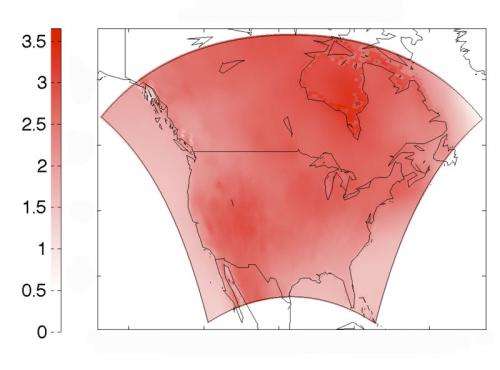Statistical analysis projects future temperatures in North America

For the first time, researchers have been able to combine different climate models using spatial statistics - to project future seasonal temperature changes in regions across North America.
They performed advanced statistical analysis on two different North American regional climate models and were able to estimate projections of temperature changes for the years 2041 to 2070, as well as the certainty of those projections.
The analysis, developed by statisticians at Ohio State University, examines groups of regional climate models, finds the commonalities between them, and determines how much weight each individual climate projection should get in a consensus climate estimate.
Through maps on the statisticians' website, people can see how their own region's temperature will likely change by 2070 - overall, and for individual seasons of the year.
Given the complexity and variety of climate models produced by different research groups around the world, there is a need for a tool that can analyze groups of them together, explained Noel Cressie, professor of statistics and director of Ohio State's Program in Spatial Statistics and Environmental Statistics.
Cressie and former graduate student Emily Kang, now at the University of Cincinnati, present the statistical analysis in a paper published in the International Journal of Applied Earth Observation and Geoinformation.
"One of the criticisms from climate-change skeptics is that different climate models give different results, so they argue that they don't know what to believe," he said. "We wanted to develop a way to determine the likelihood of different outcomes, and combine them into a consensus climate projection. We show that there are shared conclusions upon which scientists can agree with some certainty, and we are able to statistically quantify that certainty."

For their initial analysis, Cressie and Kang chose to combine two regional climate models developed for the North American Regional Climate Change Assessment Program. Though the models produced a wide variety of climate variables, the researchers focused on temperatures during a 100-year period: first, the climate models' temperature values from 1971 to 2000, and then the climate models' temperature values projected for 2041 to 2070. The data were broken down into blocks of area 50 kilometers (about 30 miles) on a side, throughout North America.
Averaging the results over those individual blocks, Cressie and Kang's statistical analysis estimated that average land temperatures across North America will rise around 2.5 degrees Celsius (4.5 degrees Fahrenheit) by 2070. That result is in agreement with the findings of the United Nations Intergovernmental Panel on Climate Change, which suggest that under the same emissions scenario as used by NARCCAP, global average temperatures will rise 2.4 degrees Celsius (4.3 degrees Fahrenheit) by 2070. Cressie and Kang's analysis is for North America - and not only estimates average land temperature rise, but regional temperature rise for all four seasons of the year.
Cressie cautioned that this first study is based on a combination of a small number of models. Nevertheless, he continued, the statistical computations are scalable to a larger number of models. The study shows that climate models can indeed be combined to achieve consensus, and the certainty of that consensus can be quantified.
The statistical analysis could be used to combine climate models from any region in the world, though, he added, it would require an expert spatial statistician to modify the analysis for other settings.
The key is a special combination of statistical analysis methods that Cressie pioneered, which use spatial statistical models in what researchers call Bayesian hierarchical statistical analyses.
The latter techniques come from Bayesian statistics, which allows researchers to quantify the certainty associated with any particular model outcome. All data sources and models are more or less certain, Cressie explained, and it is the quantification of these certainties that are the building blocks of a Bayesian analysis.
In the case of the two North American regional climate models, his Bayesian analysis technique was able to give a range of possible temperature changes that includes the true temperature change with 95 percent probability.
After producing average maps for all of North America, the researchers took their analysis a step further and examined temperature changes for the four seasons. On their website, they show those seasonal changes for regions in the Hudson Bay, the Great Lakes, the Midwest, and the Rocky Mountains.
In the future, the region in the Hudson Bay will likely experience larger temperature swings than the others, they found.
That Canadian region in the northeast part of the continent is likely to experience the biggest change over the winter months, with temperatures estimated to rise an average of about 6 degrees Celsius (10.7 degrees Fahrenheit) - possibly because ice reflects less energy away from the Earth's surface as it melts. Hudson Bay summers, on the other hand, are estimated to experience only an increase of about 1.2 degrees Celsius (2.1 degrees Fahrenheit).
According to the researchers' statistical analysis, the Midwest and Great Lakes regions will experience a rise in temperature of about 2.8 degrees Celsius (5 degrees Fahrenheit), regardless of season. The Rocky Mountains region shows greater projected increases in the summer (about 3.5 degrees Celsius, or 6.3 degrees Fahrenheit) than in the winter (about 2.3 degrees Celsius, or 4.1 degrees Fahrenheit).
In the future, the researchers could consider other climate variables in their analysis, such as precipitation.
Provided by Ohio State University Medical Center

















